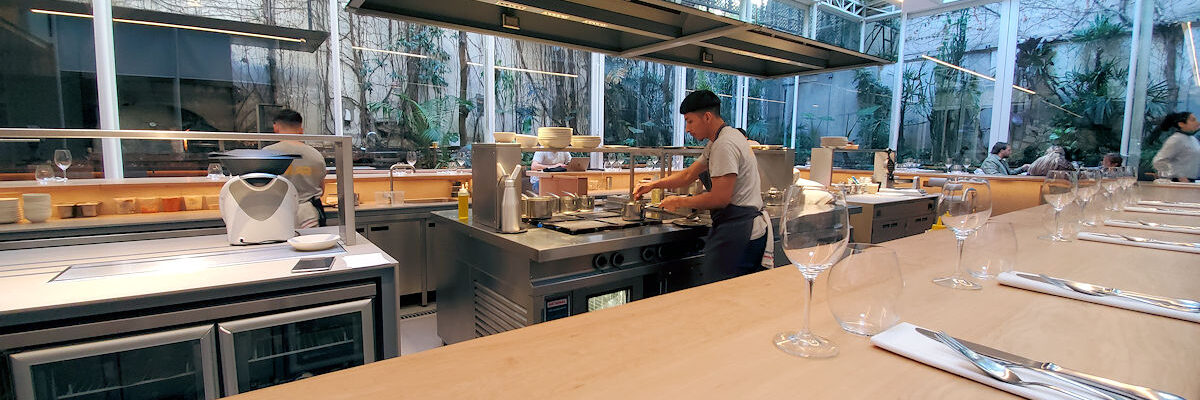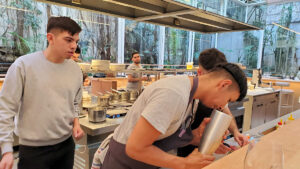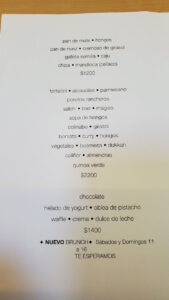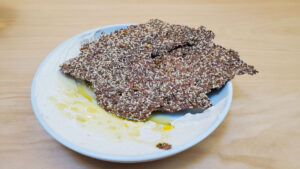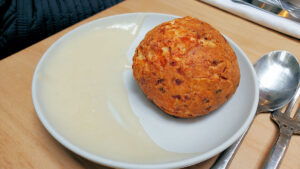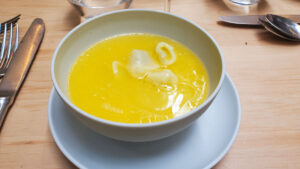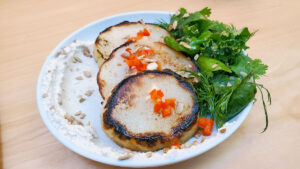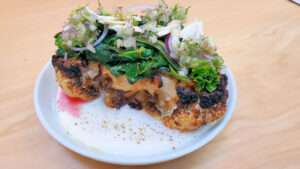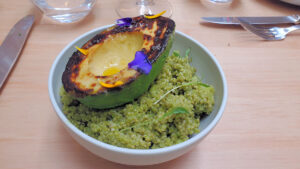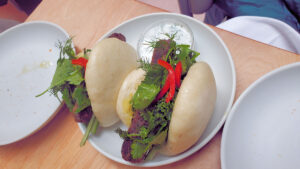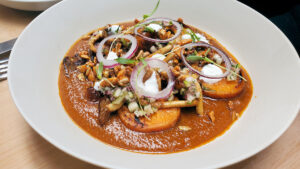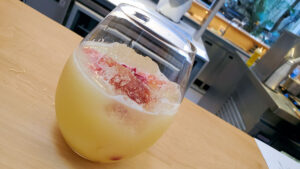It has been many moons since we checked in on Germán Martitegui. Last we saw, he was helming his half eponymous Tegui restaurant to much acclaim around the globe. Or perhaps as the “bad boy” judge on Masterchef Argentina. Towards the end of last year, Tegui closed, I’m assuming from lack of business as the pandemic ground on. On the other hand, Marititegui has headed down the vegetarian path, and perhaps he felt that trying to turn a restaurant known worldwide for meat, and particularly more exotic meats, into a vegetarian spot, was not a good move. Other high profile chefs and restaurants have learned that the hard way.
Instead, or simply the next step, he has opened a new venture, this time here in Recoleta, aside the Hub Porteño hotel (now the site of Lima Estilo Nikkei restaurant). So a warm neighborhood welcome to the other half of the eponym, MARTi, as the name is stylized, at Rodriguez Peña 1973. And yes, the place is full-on vegetarian. And finally, upfront, someone here has gotten creative vegetarian cooking right. I made a solo visit recently, and was impressed enough that I slated it for a Horde lunch the following week. One enters the space through a dress shop. The first visit, the shop was open and attended and I just walked in; the second visit, no one seemed to be there, and we had to ring the bell and wait for someone from the restaurant to come out and open the door.
The space is big, bright, and airy. The majority of the seating is at a massive rectangular bar surrounding the kitchen. There are a few scattered tables at the back and along one side, making it more conducive to chat if you’re a bigger group. But it’s fun to be where the action is, and they eye-candy doesn’t hurt (Martitegui definitely has a “type” when it comes to hiring kitchen and waitstaff – the same has been true at his past restaurants). And, the staff, both wait and kitchen, are friendly and talkative about the food and place.
The menu is straightforward, if offering up a bit of sticker shock. Each line on that is a single dish, just with a couple of the key components highlighted. The approach, it is recommended, is to order one of the bread plates from the upper section, and two of the “main” (albeit for the most part more mid-size dishes) plates, per person. Tossing in a beverage you’re looking at around 7000 pesos. Blue rate exchange is currently running about 320 pesos to the dollar, while the official rate is around 130 pesos to the dollar, two and a half times the amount! So we’re talking either $22 or $54! And that’s without dessert. Though, from having eaten there twice, I’d say that you’d probably only go for dessert if you just had one main dish. Vegetables or not, these to tend to be filling. Obviously on my solo visit I ate it all myself, on the group visit, while we each ordered our personal choices, we semi-coordinated, and shared at least tastes of everything.
The seed crackers are just that. A mix of seeds in a dehydrated cracker, held together by mysterious forces, and served up with a cashew puree and excellent olive oil. I could snack on these all day with a glass of wine at the side. 1200 pesos seems steep for crackers, though at today’s blue-rate exchange, $3.75 isn’t massively expensive, especially given how much work goes into making something like this, and the price of cashews, which is up there. Again, though, at “official” exchange, that would be $9.25, a pretty outrageous amount for crackers.
The same might be said for a single chipa, a yuca flour and cheese bread that I’ve waxed poetic about at various times in this blog. It’s a quite large chipa, easily double the size of most, though probably half the size of the spectacular one that Mengano Bodegón serves (served? I don’t know if they still do) for free with your meal. This one is excellent on its own, and we all kind of oohed and aahed as we ate them, dredged in the tasty yuca puree on the side. Hmm, that’s an idea I have to steal.
We had no idea that the artichoke tortellini with parmesan meant artichoke tortellini in a parmesan broth (unless you ask pointed questions, the staff don’t tell you much about each dish, though if you do, they will describe them in explicit detail). But the two of us who ordered this one were quite happy we didn’t know, as we probably wouldn’t have ordered it as a bowl of soup, being not overly shareable and all that. Still, we managed, and this was easily my second favorite dish of both visits. Absolutely perfect little pasta packets, and a good quantity of them, and the parmesan lemon broth is fantastic. Is it 2200 pesos, just shy of $7, fantastic? If I think of it as a plate of pasta, compared to some of the pastas I’ve had recently and talked about, yeah, it was as good or better than several of them that cost in the same range. And again, at official rate, that’s $17 a plate.
We don’t often see kohlrabi here in BA. I found some in one of the Chinese supermarkets a week or two ago and made a fantastic spicy pork and kohlrabi stew, which I’ll post about soon. So when I saw it on the menu, I had to try it. This is my favorite dish of all of them so far. Thick, wood-fired oven kohlrabi slices (you can sort of see it in the cover photo at the top, over on the left side out on the patio, a big beehive of an oven). These are served with a sunflower seed hummus, roasted bell pepper vinaigrette, and a mélange of fresh herbs.
I may as well address the one dish I didn’t really like. In a way, that’s not fair, because the flavors were good, though maybe a little muddled. The problem with this near inch and a half thick cauliflower steak, again out of the wood oven, is that it’s simply not cooked through. It’s so thick that the outside has charred but the inside is still raw. Given that they don’t have steak knives… vegetables and all… the knife provided is not up to the task of cutting through this. It was a chore, and with the small size of the plate in contrast to the “steak”, it made a mess as the almond milk foam below, and winter green sauté and pickled onions atop, went scattering. It needs to be cooked longer (perhaps par-cooked before heading into the oven for charring), put on a bigger plate, and sharper knives need to be brought with it. The cook who presented it, when I mentioned this, told me it’s a regular issue for guests. You’d think they’d take that criticism and do something about it.
This one was tasty, but a tad stodgy. Quinua cooked in “green broth” – primarily herbs of various sorts apparently, mixed with finely diced avocado, and topped with a charred avocado half. I like the flavors, but the quinua is a very heavy mass that needs a bit of loosening up with some of that broth perhaps – serve it almost more risotto style than cooked to the point of eliminating the moisture.
Excellent bao, filled with a vegetarian sausage made from mushrooms, and I believe he said lentils, or some kind of bean, but I don’t recall. It tastes like a lovely little smoked, earthy sausage. And all the pickled vegetables, and the raita style dressing, are perfect foils for the richness of the sausage.
And finally, a sweet potato curry, with lightly charred disks of the root in a moderately spicy curry base, smoky mushrooms, pickled onions, and more. Absolutely delicious, and, it lived up to the promised spice level.
On my solo visit I ordered a jasmine iced tea. It’s really refreshing and bright. Kind of a small serving in a glass like that, especially given that it’s about half ice cubes. It’s iced tea for goodness’ sake, fill the glass. Especially for 900 pesos, around $2.75, $7 official – and that was a jump from 700 pesos on the first visit, a week earlier. For the group, we ordered glasses of wine, since we couldn’t agree on red or white.
The wine list is moderately priced in terms of what the wines are, but there are very few wines that aren’t in the “boutique”, i.e., pricey, level on the list. The wine list is presented as a stack of four cards like menu above, not bound together, and seemingly in random order, printed front and back. It’s obvious, given the categories, that it’s intended to be in a specific order, but maybe clip them together so they stay that way? One huge plus – every wine on the list is available not only by the bottle, but in both glass and half glass portions.
